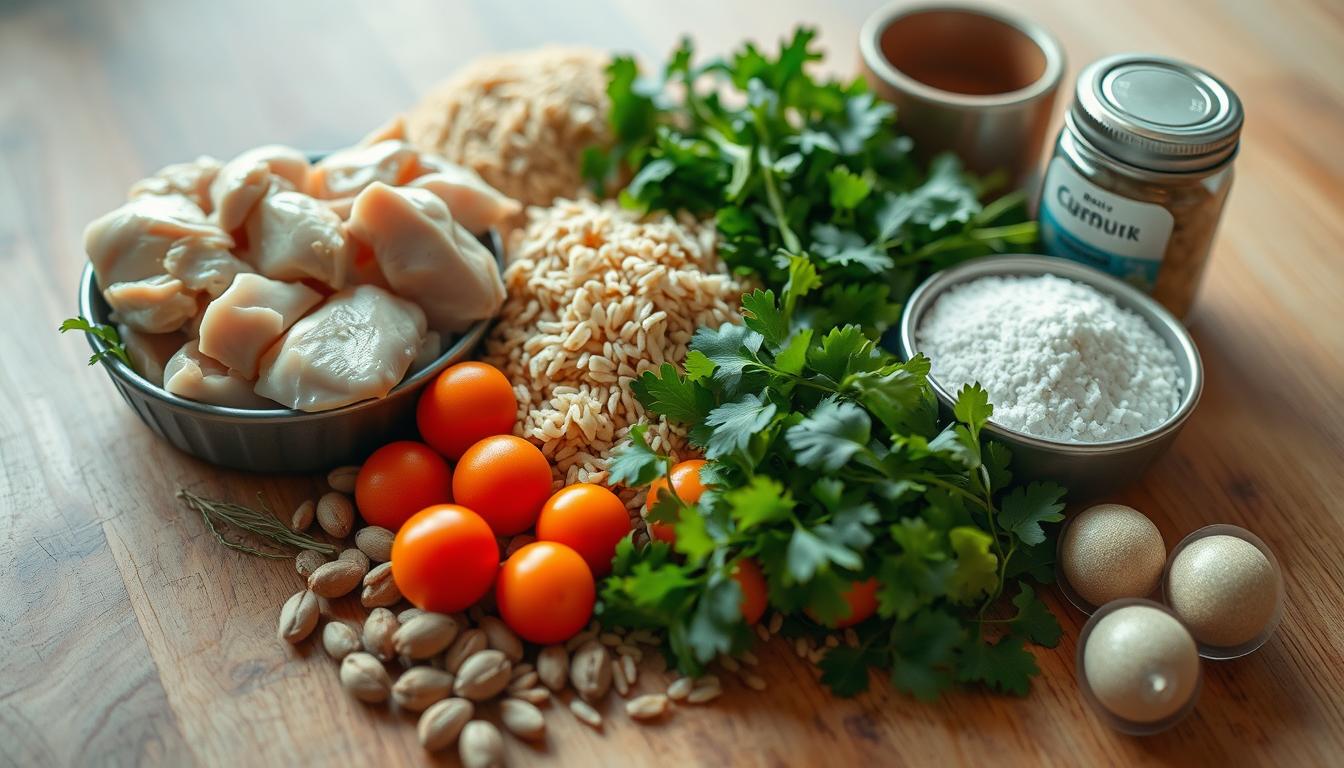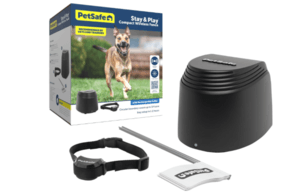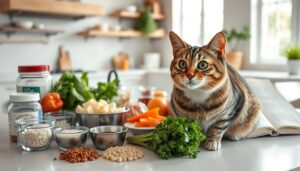Making nutritious meals for your cat can seem hard, especially if you’re watching your budget. But, with some planning, you can make healthy and delicious homemade cat food that’s also cheap.
More and more cat owners are making their cat’s food at home. This way, they can make sure their pets eat the best. You can use cheap ingredients to make wholesome meals that your cat will enjoy.
Key Takeaways
- Preparing homemade cat food can be budget-friendly.
- Nutritious ingredients can be used to create healthy meals.
- Homemade cat food allows for customization to your cat’s needs.
- It’s a great way to ensure your cat is getting the best possible nutrition.
- With a little planning, you can create delicious and healthy meals.
Why Make Your Own Cat Food?
Making your own cat food at home can change your cat’s health for the better. You get to choose what goes into their food. This means your cat gets the best start in life.
Dr. Karen Becker, a famous vet, says, “A homemade diet can lower the risk of chronic diseases.”
Health Benefits for Your Feline Friend
Homemade healthy cat food means no fillers or bad stuff. It can make your cat’s digestion better, reduce allergies, and make their coat shiny. “Cats do well on diets full of protein and low in carbs,” says a top animal nutritionist.
Choosing the right ingredients lets you make a diet just for your cat. This can help with obesity and diabetes too.
Cost Savings Over Commercial Options
Starting might seem expensive, but making your own budget-friendly cat food saves money. Buying in bulk and planning meals can cut costs. For example, a 20-pound bag of rice or oats is cheaper than small bags.
Going the DIY cat food route can save up to 30% a year. It’s good for your wallet and your cat’s health.
Understanding Your Cat’s Nutritional Needs
It’s key to know what your cat needs to eat. Cats must eat a lot of protein from animals. This keeps them healthy, from their fur to their insides.
Essential Nutrients for Cats
Cats need certain nutrients found in cat food. These include:
Protein Requirements
Cats need lots of protein from animals like chicken or beef. Protein helps keep their muscles strong.
Fats and Fatty Acids
Fats give cats energy and help them absorb vitamins. Omega-3 and omega-6 fatty acids are good for their skin and fur.
Vitamins and Minerals
Vitamins and minerals are important for many things. Vitamin A and taurine are key for their eyes and heart.
Ingredients to Avoid
It’s also important to know what not to feed your cat. Some foods can be harmful or cause allergies.
Toxic Foods for Cats
Onions, garlic, and chocolate are bad for cats. Keeping these foods away is very important.
Common Allergens
Beef, dairy, and fish can cause allergies. Watch for signs like itching or upset stomach.
Kitchen Equipment You’ll Need
Before you start making homemade cat food, you need the right tools. Making DIY cat food is easy. You don’t need fancy tools, but the basics are important.
Basic Tools for Preparation
To make simple cat food recipes, you need some basic tools. These include:
- A large pot for cooking
- A cutting board for chopping ingredients
- A sharp knife for preparing meat and vegetables
- A measuring cup and spoons for accurate ingredient measurement
- A mixing bowl for combining ingredients
Optional Equipment for Efficiency
Some optional tools can make making homemade cat treats easier. Think about getting:
- A food processor to finely chop ingredients
- A slow cooker for cooking meals over several hours
- A freezer-safe container for storing prepared meals
Having these tools will help you make many simple cat food recipes. Your cat will love the nutritious, homemade meals.
Essential Ingredients for Affordable Homemade Cat Food Recipes
Healthy and affordable homemade cat food starts with the right ingredients. Cats need a lot of protein from animal sources. Knowing the key ingredients helps make balanced and nutritious meals for your cat.
Protein Sources
Protein is very important for your cat’s diet. Affordable protein sources are chicken, turkey, and fish. These can be bought in big amounts and are full of amino acids your cat needs.
You can also use eggs as a protein source. They can be cooked or raw, based on what you like. But, make sure the fish is fresh and varied to avoid mercury.
- Chicken: Rich in protein and can be bought in bulk.
- Turkey: Another affordable protein source that’s nutrient-rich.
- Fish: Provides essential omega-3 fatty acids.
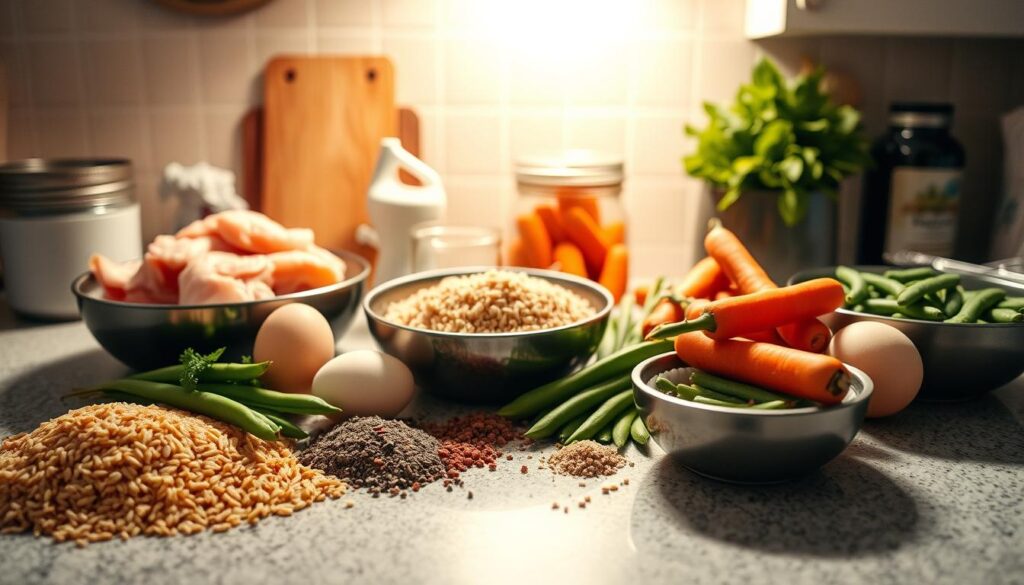
Supplements and Additives
While protein sources are the main part of your cat’s diet, supplements and additives can add extra nutrition. Taurine is an amino acid that’s good for the heart. Omega-3 fatty acids from fish oil make skin and coat healthier. Vitamins and minerals like Vitamin E and calcium are also important.
Always talk to a vet before adding any supplements. This makes sure they’re right for your cat.
Budget-Friendly Shopping Tips
To make homemade cat food budget-friendly, buy ingredients in big amounts. Plan your meals ahead and look for sales. Using coupons can also save money. Plus, using chicken and eggs as protein sources can be cheaper without losing nutrition.
- Buy in bulk to save on costs.
- Plan meals around sales and stock up.
- Use coupons for additional savings.
Basic Chicken and Rice Recipe
This simple chicken and rice recipe is great for your cat. It’s easy to make and full of nutrients. Your cat will love it.
Ingredients List
You might already have these ingredients at home. You’ll need:
- 1 pound of boneless, skinless chicken breast or thighs
- 1 cup of cooked white or brown rice
- 1/2 cup of finely chopped vegetables (such as carrots or green beans)
- 1 teaspoon of fish oil (optional)
Step-by-Step Instructions
Making this simple cat food recipe is easy. Just follow these steps:
- Cook the rice as the package says.
- Bake or boil the chicken until it’s done.
- Chop the cooked chicken into small pieces.
- Mix the chicken, rice, and chopped vegetables together.
- Add fish oil if using, and mix well.
Nutritional Information
This nutritious cat food recipe is balanced. The chicken gives protein, and the rice is easy to digest. The veggies add vitamins and minerals.
Budget-Friendly Fish Recipe
Looking for cheap and healthy cat food? Try a fish-based recipe. Fish is full of protein and is easy on the wallet.
Ingredients List
Here’s what you need for this fish recipe:
- 1 pound of cod or haddock fillets
- 1/2 cup of cooked brown rice
- 1/4 cup of finely chopped spinach
- 1 teaspoon of fish oil
- 1 teaspoon of flaxseed oil
Instructions
Making this cat food is easy. Just follow these steps:
- Preheat your oven to 350°F (175°C).
- Place the fish fillets on a baking sheet lined with parchment paper.
- Bake the fish in the oven for 10-12 minutes, or until it’s cooked through.
- Remove the fish from the oven and let it cool.
- Flake the cooked fish into small pieces and mix it with the cooked brown rice, chopped spinach, fish oil, and flaxseed oil.
Nutritional Information
This fish recipe is tasty and full of good stuff. Here’s what it offers:
- Protein: 30 grams per serving
- Fat: 10 grams per serving
- Omega-3 fatty acids: 1 gram per serving
- Vitamin D: 20% of the daily recommended intake per serving
This recipe has all the nutrients your cat needs to stay healthy.
Beef and Vegetable Cat Food
Beef and veggies make a tasty, healthy cat food. It’s easy to make and better than store-bought food.
Ingredients List
Here’s what you need for this easy cat food recipe:
- 1 pound ground beef
- 1 cup mixed veggies (like carrots, green beans, and peas)
- 1/2 cup cooked brown rice
- 1 teaspoon fish oil
- 1 egg yolk
Step by Step Instructions
Making this homemade cat food is simple. Just follow these steps:
- Brown the ground beef in a pan over medium heat until it’s fully cooked.
- Add the mixed veggies and cook until they’re tender.
- Mix in the cooked brown rice, fish oil, and egg yolk.
- Let the mix cool before giving it to your cat.
Nutritional Information
This cat food is full of protein and fiber. It’s a nutritious cat food choice. Each serving has about 350 calories. It also has important vitamins and minerals for your cat’s health.
Quick and Easy No-Cook Cat Treats
Want to make your cat happy? Try making no-cook cat treats. They’re tasty and healthy. Plus, it’s fun to make them together.
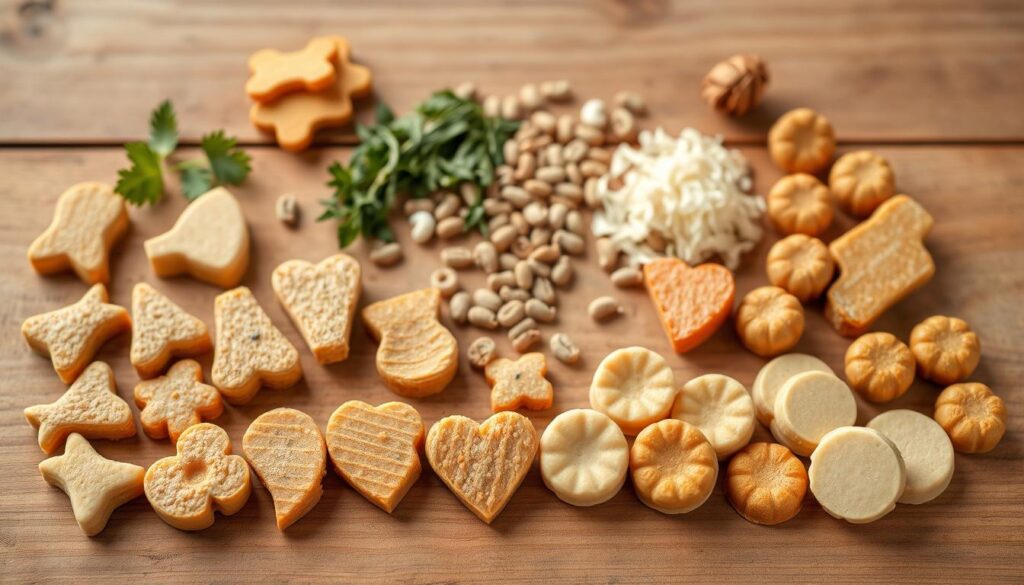
Tuna Treats Recipe
Making tuna treats is easy. Mix canned tuna with water to make a paste. Shape it into small pieces. Add chopped parsley for fresh breath.
Freeze the tuna for 30 minutes to firm it up.
Catnip Crunchies Recipe
Catnip crunchies are fun to make. Mix oats, dried catnip, and olive oil. Shape into balls and chill for 30 minutes.
Cats love the smell and taste of catnip.
Freeze-Dried Liver Bites
Freeze-dried liver bites are protein-rich. Slice liver into thin strips and freeze. Feed them as a crunchy snack.
Freeze-drying keeps nutrients in.A feline expert says, “Freeze-dried liver is a favorite.”
“Treats should not make up more than 10% of your cat’s daily calorie intake.”
Want to make treats special? Try different ingredients. Use salmon instead of tuna or change the oil.
Transitioning Your Cat to Homemade Food
Changing your cat’s food to homemade needs patience and a good plan. A quick diet change can upset their stomach. So, start by adding new foods slowly.
Gradual Introduction Method
Begin by mixing a little homemade food with their old food. Slowly add more homemade food over 7-10 days. This helps their body get used to the new food.
Day 1-3: Mix 25% homemade food with 75% current diet.</p>
<p>Day 4-6: Mix 50% homemade food with 50% current diet.</p>
Day 7-10: Mix 75% homemade food with
25% current diet.</p>
| Day | Homemade Food Percentage | Current Diet Percentage |
|---|---|---|
| 1-3 | 25% | 75% |
| 4-6 | 50% | 50% |
| 7-10 | 75% | 25% |
Troubleshooting Picky Eaters
Some cats are very picky. If your cat won’t eat the homemade food, try warming it a bit. This makes it smell better. You can also add a little low-sodium chicken broth to make it taste better.
If your cat still won’t eat it, talk to your vet. They can check if there’s a health problem. Making sure the homemade food is nutritious and balanced is important for a smooth change.
Storage and Meal Planning
Keeping homemade DIY cat food fresh is key. It helps keep the food good for your cat. When you make simple cat food recipes, make sure it stays fresh and safe.
Freezing and Portioning
Freezing is a great way to keep cat food fresh. Portion it out before freezing for easy meals. This saves time and reduces waste.
Use airtight containers or freezer bags. They help prevent freezer burn and keep food fresh.
Shelf Life Guidelines
Knowing how long your cat food lasts is important. Frozen homemade cat food can last months. Here’s a simple guide:
| Storage Method | Shelf Life |
|---|---|
| Frozen | 3-4 months |
| Refrigerated | 3-5 days |
Follow these tips and plan meals well. You’ll give your cat budget-friendly cat food that’s healthy and tasty.
Cost Analysis: Homemade vs. Commercial Cat Food
Feeding your cat can be expensive. Making your own cat food might save money. But, it takes time and money to start.
The cost of homemade cat food changes with the ingredients. Organic or special ingredients cost more. Common ingredients are cheaper.
Price Breakdown Per Serving
Let’s look at how much homemade cat food costs. A serving can cost between $0.50 to $1.50. This depends on what you use.
| Food Type | Cost Per Serving | Monthly Cost (30 servings) |
|---|---|---|
| Homemade Cat Food (Basic) | $0.75 | $22.50 |
| Commercial Dry Cat Food | $1.00 | $30.00 |
| Premium Commercial Cat Food | $1.50 | $45.00 |
Long-Term Savings
Homemade cat food might cost more at first. But, it can save money in the long run. Buying in bulk and planning meals helps.
Long-term benefits include saving money and your cat’s health. This can lower vet bills too.
Conclusion
Making healthy cat food at home is easy and saves money. You can use cheap ingredients and simple recipes. This way, you make sure your cat gets the right food.
Homemade cat food lets you pick the best ingredients. You avoid bad stuff in some store-bought foods. The recipes in this article help you make tasty, healthy meals for your cat.
Switching to homemade cat food is good for your cat’s health. It gives them the nutrients they need to be happy and healthy. Try making homemade cat food today and see how it helps your pet.
FAQ
What are the benefits of making homemade cat food?
Making homemade cat food lets you pick the ingredients. This means your cat gets what they need without bad stuff. It also saves money over time.
How do I ensure my cat is getting a balanced diet with homemade food?
For a balanced diet, use different protein sources and healthy fats. Add vitamins and minerals too. Talk to a vet or animal nutritionist to make sure it’s right for your cat.
What are some common ingredients to avoid in homemade cat food?
Don’t use onions, garlic, chocolate, grapes, or raisins. They’re bad for cats. Also, skip fish with a lot of mercury and raw meat, eggs, or bones.
Can I make homemade cat treats, and what are some simple recipes?
Yes, you can make cat treats at home. Try tuna treats, catnip crunchies, or freeze-dried liver bites. These are easy to make.
How do I transition my cat to homemade food?
Start by mixing a little homemade food with their old food. Slowly add more homemade food over a few days. Watch how your cat does and adjust as needed.
How should I store homemade cat food to maintain freshness?
Keep homemade cat food in airtight containers in the fridge for a few days. Or freeze it for longer. Divide it into portions to make serving easy and avoid thawing too much.
Is homemade cat food more budget-friendly than commercial cat food?
Homemade cat food might cost more at first. But, it can save money over time. Buying in bulk and planning meals helps cut costs.

